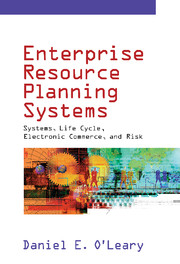2 - Systems and Technology Background
from PART ONE - INTRODUCTION AND BACKGROUND
Published online by Cambridge University Press: 05 June 2012
Summary
The purpose of this chapter is to provide some brief background information on systems and technology to facilitate understanding of ERP issues. In order to do that, some background on computing, networking, databases, software, software choice, and reengineering is provided. Within each category, the background information is applied to some related ERP (in particular, SAP) concepts in order to tie the background material directly to ERP.
Computing
Historically, enterprise computing was heavily mainframe based. In roughly 1993 (see e.g. Frye 1994), client server versions of enterprise computing applications began to be more available.
Mainframe Computing
In a mainframe computing environment, all the computing is done on a single computer (box). Typically, this is handled by allowing users to share (e.g., via time sharing) the computing resource – the mainframe computer. The user would typically be at a terminal that had no computing capabilities (or at a personal computer that emulated a terminal).
Client Server Computing
Over time, the user began to have increasing computing capabilities locally. As a result, computing began to shift some of the processing to the user's computing facilities. This ultimately resulted in what is now called “client server” computing, where client and server are linked so that the computing and storage can be distributed between the client and the server. The term “client” refers to the user's computer, while the “server” refers to some other (e.g., centrally located) computing source that provides computing resources, software, or data.
- Type
- Chapter
- Information
- Enterprise Resource Planning SystemsSystems, Life Cycle, Electronic Commerce, and Risk, pp. 13 - 24Publisher: Cambridge University PressPrint publication year: 2000

